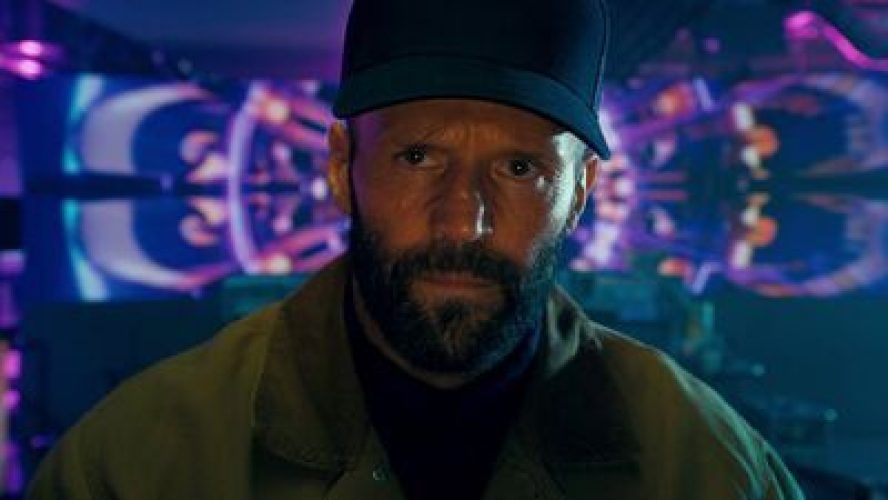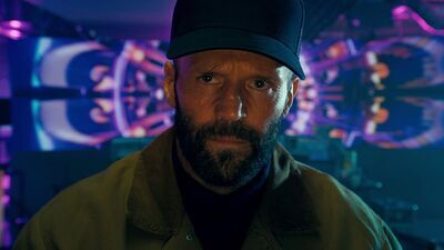At the end of “The Beekeeper,” an amazing thing happens: they fade to black and roll the credits.
I saw the film earlier this year (it’s on home video now and worth $5) and was slightly flummoxed. Written and directed by David Ayer (“Fury“), it stars Jason Statham as a former commando turned vigilante waging violent warfare against swindlers who hide behind the anonymity of the Internet. It’s one of those films with a conspiracy that Goes Right to the Top, so of course it ends in a massive oceanside villa where some of the most important people on earth have gathered. Statham’s character sneaks into the closely guarded compound, does what men like him do in these sorts of films, then puts on scuba gear and lowers himself into the ocean, whereupon the camera pans up to the sky and the credits begin. It feels like the ending to a much older movie. And I mean that as high praise. So did the endings of “Ferrari,” “Falling Leaves,” “A Haunting in Venice” and “Barbie” (a deadpan one-liner worthy of Billy Wilder, who did some of the best endings in movie history).
All of the great directors know how to get out of the story once it’s over. You can argue about the advisability of the running times of certain films by Martin Scorsese, Stanley Kubrick, David Lean, Akira Kurosawa, or Sergio Leone, but rarely about their choice of when and how to end things. Think of “The Good, The Bad and the Ugly” going out on a freeze-frame of Eli Wallach being shot down from a noose by Clint Eastwood. Or “2001: A Space Odyssey,” which takes its time getting into that cosmic hotel room, but as soon as the Starchild floats into frame and turns to show its face, ends the movie.
There are contemporary filmmakers who get how to get out. Bong Joon-Ho is a modern master of endings. David Fincher is good at endings, even when the ending isn’t exactly the ending. “The Killer,” a tight two-hour movie, has an “epilogue,” but it lasts less than a minute. Wes Anderson never spends a second longer in his fictional worlds than he has to; even “The Grand Budapest Hotel,” which has framing device upon framing device upon framing device, he exits all of them swiftly once old Zero is done with his tale. The Coen Brothers have a nearly impeccable track record when it comes to endings. Even the ones that are generally thought of as lesser (like “The Ladykillers” and “The Hudsucker Proxy”) end with elegant brevity. The final shots of most of their films rank with the best final shots in cinema, whether it’s the bowling ball hitting a strike in the background in “The Big Lebowski” or the closeup of Gabriel Byrne in “Miller’s Crossing” where he grasps the brim of the hat he’s been chasing and pulls it down tight on his head.
I don’t know when the modern era of end-bloat began—maybe with 2004’s “The Lord of the Rings: The Return of the King,” which had 15 minutes of epilogue(s) after the main action had wrapped up. But at least that had the excuse of being a three-film epic based on a book that took even longer to finish. In the age of content, where the point is to create (or revive, or clone) something in order to create an endless stream of monetizable situations, movies seem to have trouble remembering how to be movies. They’ll give you scene after scene that tells you what happened to all of the supporting characters and check in on all the important relationships, and maybe give you a hint of where a sequel (or spinoff) might go, and in the age of Marvel/DC they’d even tack on a mid-credits and post-credits scene. Matt Reeves’ “The Batman,” a very good movie on a familiar subject, has what feels like four, possibly five endings.
It’s starting to feel as if nobody knows how to play this particular game anymore. That’s why it’s so exciting to encounter someone who does.
At the end of “The Beekeeper,” an amazing thing happens: they fade to black and roll the credits. I saw the film earlier this year (it’s on home video now and worth $5) and was slightly flummoxed. Written and directed by David Ayer (“Fury”), it stars Jason Statham as a former commando turned vigilante waging violent warfare against swindlers who hide behind the anonymity of the Internet. It’s one of those films with a conspiracy that Goes Right to the Top, so of course it ends in a massive oceanside villa where some of the most important people on earth have gathered. Statham’s character sneaks into the closely guarded compound, does what men like him do in these sorts of films, then puts on scuba gear and lowers himself into the ocean, whereupon the camera pans up to the sky and the credits begin. It feels like the ending to a much older movie. And I mean that as high praise. So did the endings of “Ferrari,” “Falling Leaves,” “A Haunting in Venice” and “Barbie” (a deadpan one-liner worthy of Billy Wilder, who did some of the best endings in movie history). All of the great directors know how to get out of the story once it’s over. You can argue about the advisability of the running times of certain films by Martin Scorsese, Stanley Kubrick, David Lean, Akira Kurosawa, or Sergio Leone, but rarely about their choice of when and how to end things. Think of “The Good, The Bad and the Ugly” going out on a freeze-frame of Eli Wallach being shot down from a noose by Clint Eastwood. Or “2001: A Space Odyssey,” which takes its time getting into that cosmic hotel room, but as soon as the Starchild floats into frame and turns to show its face, ends the movie. There are contemporary filmmakers who get how to get out. Bong Joon-Ho is a modern master of endings. David Fincher is good at endings, even when the ending isn’t exactly the ending. “The Killer,” a tight two-hour movie, has an “epilogue,” but it lasts less than a minute. Wes Anderson never spends a second longer in his fictional worlds than he has to; even “The Grand Budapest Hotel,” which has framing device upon framing device upon framing device, he exits all of them swiftly once old Zero is done with his tale. The Coen Brothers have a nearly impeccable track record when it comes to endings. Even the ones that are generally thought of as lesser (like “The Ladykillers” and “The Hudsucker Proxy”) end with elegant brevity. The final shots of most of their films rank with the best final shots in cinema, whether it’s the bowling ball hitting a strike in the background in “The Big Lebowski” or the closeup of Gabriel Byrne in “Miller’s Crossing” where he grasps the brim of the hat he’s been chasing and pulls it down tight on his head. I don’t know when the modern era of end-bloat began—maybe with 2004’s “The Lord of the Rings: The Return of the King,” which had 15 minutes of epilogue(s) after the main action had wrapped up. But at least that had the excuse of being a three-film epic based on a book that took even longer to finish. In the age of content, where the point is to create (or revive, or clone) something in order to create an endless stream of monetizable situations, movies seem to have trouble remembering how to be movies. They’ll give you scene after scene that tells you what happened to all of the supporting characters and check in on all the important relationships, and maybe give you a hint of where a sequel (or spinoff) might go, and in the age of Marvel/DC they’d even tack on a mid-credits and post-credits scene. Matt Reeves’ “The Batman,” a very good movie on a familiar subject, has what feels like four, possibly five endings. It’s starting to feel as if nobody knows how to play this particular game anymore. That’s why it’s so exciting to encounter someone who does. Read More


